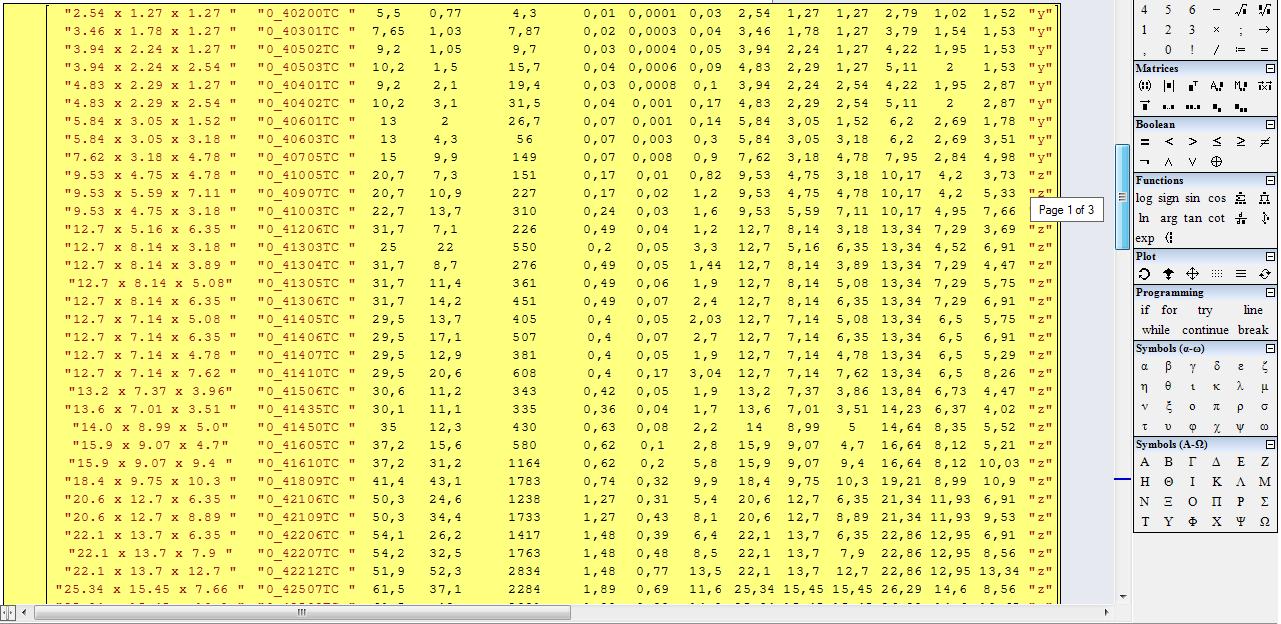How should we do to gain space on the SMath page. - Сообщения
Because in my calculations, I have often stored large matrix data, I started from this aspect and I wondered how I could make a very large array (let's say, for example, format 100x25) to reduce it to a negligible space while keeping all the data stored in it at that time? Is this possible? How to proceed? I would like examples from experts in the field. Thank you.
See the Getting started with SMath example, where the individual sections are contained in area regions.
If you just want to limit the display size of matrices, then you just shrink the math region (drag the lower right corner with the mouse) or use a table region (Insert> Table). Use the settings menu of the table region to control display.
See Handbuch pages 66 (Table region) and 119 (display of large matrices). It is in german but you either guess the idea from the screenshots or use an online translator.
WroteYou can use collapsible area regions (Insert> area)...
Although I did not specify from the beginning, I have referred to other methods of minimizing matrices - not collapsible areas. The best news for me, along with your answer, is that there is a specialized SMath manual. My immediate question is whether this manual is available in French, or English ?! Although in my country there was an important German minority, I did not stay too comfortable with this language. Thanks once again for your very competent answers. Otherwise, all the best.
WroteMy immediate question is whether this manual is available in French, or English ?! Although in my country there was an important German minority, I did not stay too comfortable with this language.
The handbook is written in German. As long as I don't find a handy way to handle bilingual documents in LyX (that's what I use to write the handbook) I can't maintain an english version. I have only very little command of French.
Google Translate refused to translate the handbook due to it's size. You might succeed by splitting it into smaller parts. Translation of individual paragraphs is no problem at all.
An alternative might be the interactive handbook, which is bilingual german/english. Some pages also have a french translation. The interactive handbook, however, is outdated a bit.
If you didn't know about the handbook, you might want to visit the SMath resources viewer (red Apps button in the forum header) and browse the 3rd party resources.
WroteI have referred to other methods of minimizing matrices
Never heard of such thing "method for minimizing matrix".
Yes via Wavelets, but will freak the values.
If your matrix represents a collection of the same measurement,
you can use the PCA Analysis [Principal Component Analysis].
The matrix will resume in the two pairs of PCA data.
mod: images too large, moved under spoiler
Bonjour Jean Giraud
I am referring specifically to matrices containing input data that are made by definition equality. Above I gave an example of the 68x15 array, for which I used two screenshots. I have previously taken the example of a 100x25 format matrix. When defining such a matrix, SMath does not provide tools to reduce it to acceptable dimensions, as it offers when the matrix is subsequently called through a non-definition equality. For example, if I have a matrix with combined data containing numeric values and / or alphanumeric strings and / or matrix elements, then at the dimensions suggested by me, this array will extend over more than one SMath work page in both directions. It becomes very difficult in these conditions to subsequently edit the mathematical process, correlating the relationships that precede the matrix with those that succeed it. There is the possibility of closing such mammoth matrices in collapsible areas after mkraska's suggestion from where to be called by equality without definition. But if there are many such matrices inside a mathematical process, things will get even more complicated. That's what it is.
Sinon a bientôt et tout le meilleur.
(sorry I can't attach examples right now but there are several around here)
Thanks for the guidelines. I suspected there were such possibilities. However, editing in multiple files brings with it other problems. I often prefer to edit a work harder than to solve these problems. Otherwise, all the best.
@mkraska: Trying to use the Google automated translator, using the copy-past method, I have obtained texts like the one in the image. The manual seems very interesting. I will try to use it only intuitively by comparing the figures and the various mathematical relationships.

Post Scriotum: I'm sorry I broke the topic format by attaching two atypical images. If moderators find it useful, then I can edit or remove the two screenshots from my previous post.
WroteCiao Davide
@mkraska: Trying to use the Google automated translator, using the copy-past method, I have obtained texts like the one in the image. The manual seems very interesting. I will try to use it only intuitively by comparing the figures and the various mathematical relationships.
That depends on what PDF viewer you are using. I had the same problem with PDF Exchange Editor. With Adobe reader it worked.
WroteSinon a bientôt et tout le meilleur.
Toi aussi Nicolas: bonne journée, bonne vie, bon Smath.
I believe "Nicolas is your surname ... like Peter.
From that huge matrix, you can do almost anything you want before post processing:
1. submatrix for a chunk rectangular/square
2. specify a selection /rows/cols
3. replace part of a matrix by another
4. rotate a gray scale image matrix
5. rotate an RGB image matrix
6. zoom up/down any image matrix
.....
If you attach that huge matrix and explain what you want to do from it
we can probably reply very soon.
Cheers ... Jean
NicolasMatrix.sm (81,84 КиБ) скачан 627 раз(а).
Wrote... Toi aussi Nicolas: bonne journée, bonne vie, bon Smath.
I believe "Nicolas is your surname ... like Peter. ...
Merci beaucoup. Moi aussi, je souhaite à tout le monde.
By 2004, I was working with a team of French engineers. Because my name is quite common in my country - Olaru (potter) Nicolae (nicholas) - I was not able to find a nickname on the internet. One of my fellow Frenchmen has suggested this nickname I have not changed since then.
My problem is not to process the matrix. Once defined, that mammoth matrix (and others, often) becomes an obstacle on the SMath work page, hard to overcome. Often I have to review the mathematical relationships that precede that matrix and I will have to do a lot of scrolls to climb it. In the absence of a handbook (or rather unable to translate it from German) it will be very difficult to learn how to replace such a mammoth matrix, for example with a SMath table, which assumes that it was provided with the possibility of adjusting the dimensions. To overcome these shortcomings, I will try to find examples and tutorials on the Internet. Thank you very much for your interest and your competent guidance. Thank you also to all.
For inspection of the matrix with just some window of it exposed, the table region is good.
Note that you can't use the table region for input or edit.
Import by the various flavours of importdata (CSV/TXT, ODS or XLSX) is the most convenient option for access to data. This, however, requires the data files to be bundled with the smath sheet.
You also could put the matrices into a separate sm sheet and import them using include() from the include plugin. But I can't see the benefit over directly importing them.
Wrotehow to replace such a mammoth matrix, for example with a SMath table, which assumes that it was provided with the possibility of adjusting the dimensions.
row/cols adjustable matrix, Mathcad style, c/w row/col identifiers
that is not available in Smath as conveniently than Mathcad.
You can examine few rows at time, even by selected chunks of cols.
Easy to add the numeric up/dn push button. I have done that few times.
Regarding Jean Giraud's recommendations, I can say that they are tricks similar to those used in MathCAD (there are only differences in SMath application) and I have been using them for some time now. Finally, I concluded that the best solution (suggested by Martin Kraska in one of his previous posts) namely the use at the beginning of the SMath work page of a collapsible area that closes the entire database needed for that file calculation. The inconveniences of enormous matrices remain only if they need to be revised later. Thanks once again to all for guidance. All the best.
WroteThe inconveniences of enormous matrices remain only if they need to be revised later. Thanks once again to all for guidance. All the best.
Same problem in Mathcad. We had instances of square matrices over 16 000 000.
Sure, you can collapse and inspect piece wise as suggested.
Cheers Nicolas ... Jean
WroteSame problem in Mathcad. We had instances of square matrices over 16 000 000. ...
16 million is ... wow! However, MathCAD tables are available for input data storage and can then be reduced to the minimum space required. Even in such cases, collapsible areas are useful. I used them there as well. What I was saying on a different subject somewhere over tens of pages, actually referred to the un-collapsed workspace. I am now trying to get out of MathCAD's patterns, while still adapting the possibilities of SMath to my skills already acquired over time.
Bonne chance Jean Giraud.
Wrote16 million is ... wow!
From recollection, such a monster toke > 10 min to copy/paste,
even if Mathcad was hyperfast, it has to unwrap the matrix in vector
and pack it back ... quite a huge vector 16^2 *1000000^2 !!!
Over Atlantic, Nicolas is Nick or Nico.
Bonne journée Nico ... Jean
That's how it is. I remembered that Canada is not actually France and that the ocean has to cross. Yes, we are also Nick and Nico, and we also have Nicu, Culae, Nae, etc.
Bonne chance.
- Новые сообщения
- Нет новых сообщений


